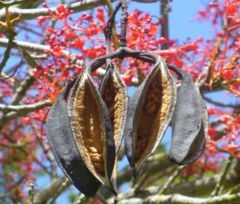Erythrina fusca: Difference between revisions
No edit summary |
No edit summary |
||
| Line 1: | Line 1: | ||
{{Inc| | |||
Erythrina fusca, Lour. Tree-like, 8 ft., the bark fuscous (brownish), bearing short prickles, the branching diffuse: Lvs. unarmed; lfts. lanceolate, entire, glabrous: fls. brown-red, in terminal racemes; calyx somewhat bilabiate, the lips entire and erect; standard very long, obtuse, convolute in a tube; stamens long, connate at base: pod long, terete, articulate, pilose; seeds oblong. Cochin-China. | |||
}} | |||
{{Taxobox | {{Taxobox | ||
| color = lightgreen | | color = lightgreen | ||
Revision as of 14:44, 25 September 2009
| Standard Cyclopedia of Horticulture |
|---|
|
Erythrina fusca, Lour. Tree-like, 8 ft., the bark fuscous (brownish), bearing short prickles, the branching diffuse: Lvs. unarmed; lfts. lanceolate, entire, glabrous: fls. brown-red, in terminal racemes; calyx somewhat bilabiate, the lips entire and erect; standard very long, obtuse, convolute in a tube; stamens long, connate at base: pod long, terete, articulate, pilose; seeds oblong. Cochin-China.
|
Erythrina viarum" Erythrina caffra
Erythrina viarum"
| Erythrina fusca {{{status}}} Fossil range: {{{fossil_range}}}
| ||||||||||||||||||||||||||||||||||||||||||||||||||||||||||||||||||
|---|---|---|---|---|---|---|---|---|---|---|---|---|---|---|---|---|---|---|---|---|---|---|---|---|---|---|---|---|---|---|---|---|---|---|---|---|---|---|---|---|---|---|---|---|---|---|---|---|---|---|---|---|---|---|---|---|---|---|---|---|---|---|---|---|---|---|
 | ||||||||||||||||||||||||||||||||||||||||||||||||||||||||||||||||||
| Plant Info | ||||||||||||||||||||||||||||||||||||||||||||||||||||||||||||||||||
| ||||||||||||||||||||||||||||||||||||||||||||||||||||||||||||||||||
| Scientific classification | ||||||||||||||||||||||||||||||||||||||||||||||||||||||||||||||||||
| ||||||||||||||||||||||||||||||||||||||||||||||||||||||||||||||||||
| [[{{{diversity_link}}}|Diversity]] | ||||||||||||||||||||||||||||||||||||||||||||||||||||||||||||||||||
| {{{diversity}}} | ||||||||||||||||||||||||||||||||||||||||||||||||||||||||||||||||||
| Binomial name | ||||||||||||||||||||||||||||||||||||||||||||||||||||||||||||||||||
| Erythrina fusca Lour. | ||||||||||||||||||||||||||||||||||||||||||||||||||||||||||||||||||
| Trinomial name | ||||||||||||||||||||||||||||||||||||||||||||||||||||||||||||||||||
| {{{trinomial}}} | ||||||||||||||||||||||||||||||||||||||||||||||||||||||||||||||||||
| Type Species | ||||||||||||||||||||||||||||||||||||||||||||||||||||||||||||||||||
| {{{type_species}}} | ||||||||||||||||||||||||||||||||||||||||||||||||||||||||||||||||||
| {{{subdivision_ranks}}} | ||||||||||||||||||||||||||||||||||||||||||||||||||||||||||||||||||
| [[Image:{{{range_map}}}|{{{range_map_width}}}|]] | ||||||||||||||||||||||||||||||||||||||||||||||||||||||||||||||||||
| Synonyms | ||||||||||||||||||||||||||||||||||||||||||||||||||||||||||||||||||
| Erythrina glauca Erythrina caffra |
The legume tree Erythrina fusca is known by many common names including coral bean, purple coraltree, gallito, bois immortelle, bucayo, and bucare. It has the widest distribution of any Erythrina species; it is the only one found in both the New and Old Worlds. It grows throughout tropical Asia and the Pacific, Central America, and into the Amazon Basin.
It is a deciduous tree with spiny bark and light orange flowers. Its legume pods reach 20 centimeters in length and contain dark brown seeds. Its legume pods can disperse across oceans and the tree can grow in a wide range of habitats, two reasons for its current broad distribution.
Like many other species in genus Erythrina, E. fusca contains toxic alkaloids which have been utilized for medicinal value but are poisonous in larger amounts. The most common alkaloid is erythraline, which is named for the genus. The new buds and leaves are eaten as a vegetable. The easy-to-grow and attractive flowering tree is cultivated as an ornamental shade and hedge plant. It is a common shade tree in cacao plantations. It attracts hummingbirds, which help to pollinate its flowers.
It is the official flower of the Venezuelan state of Trujillo.